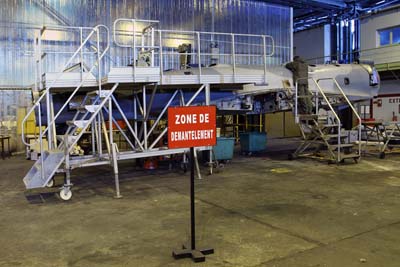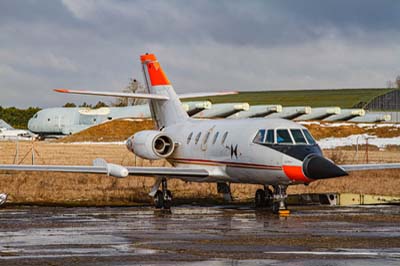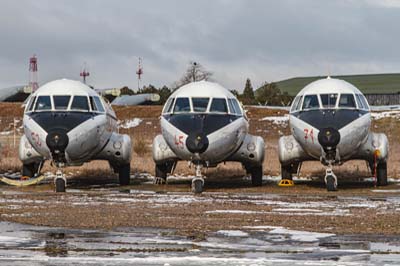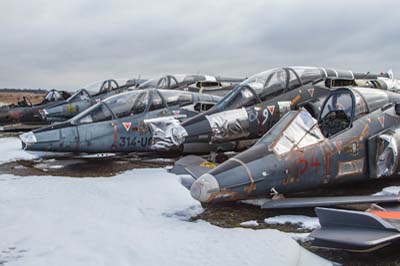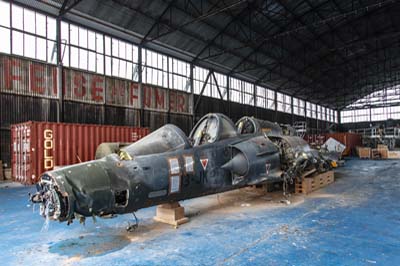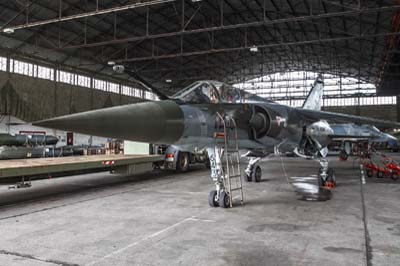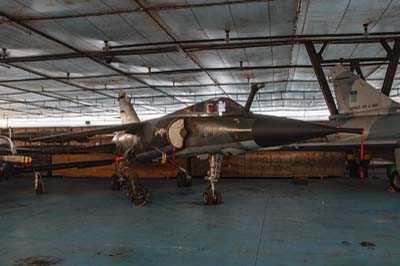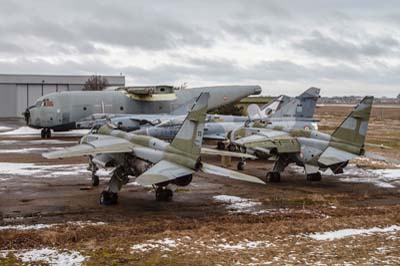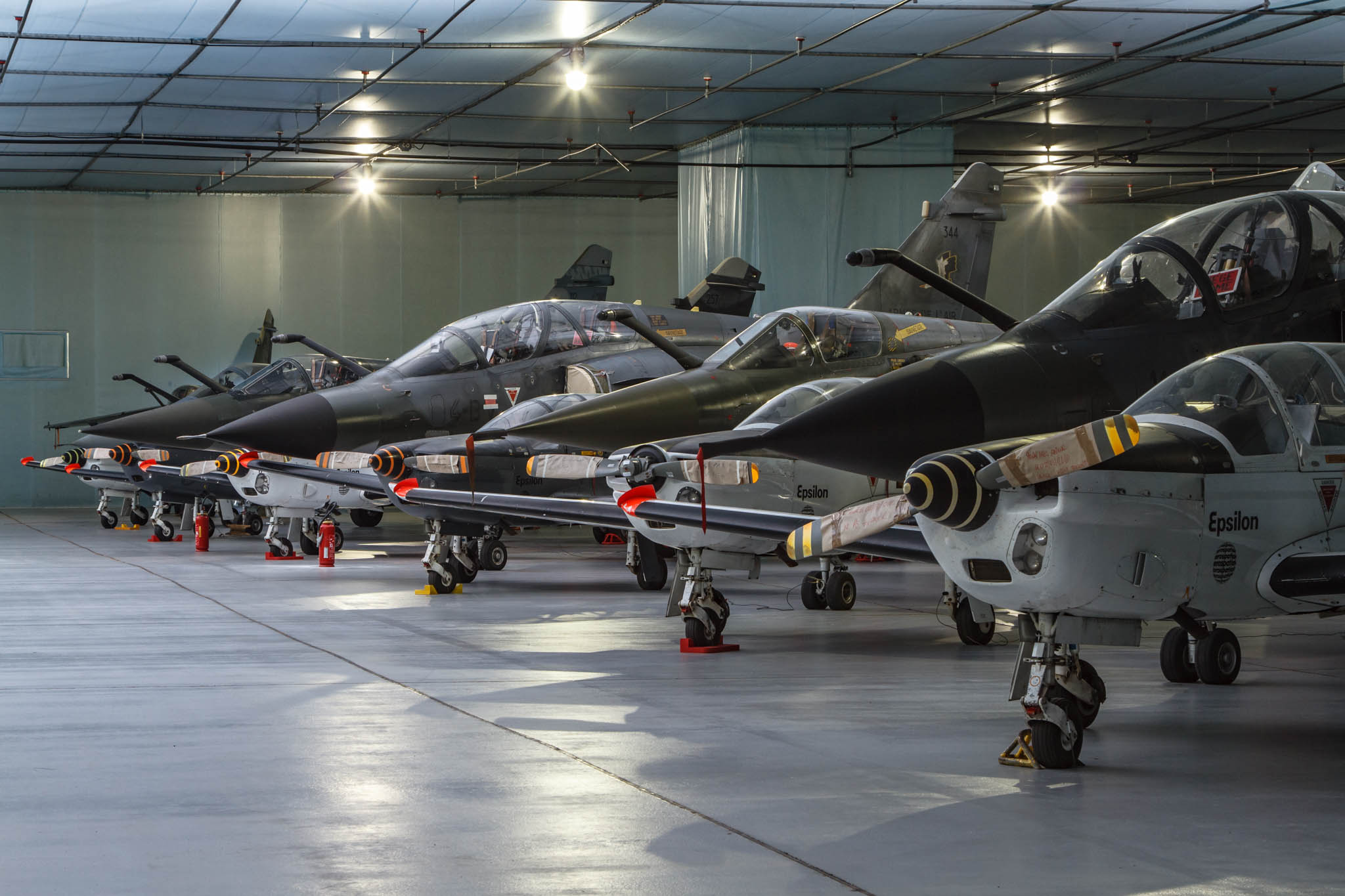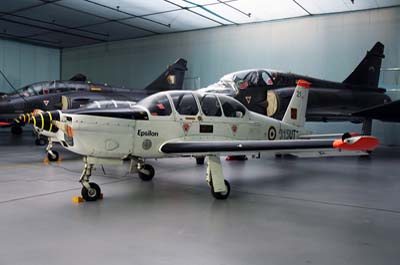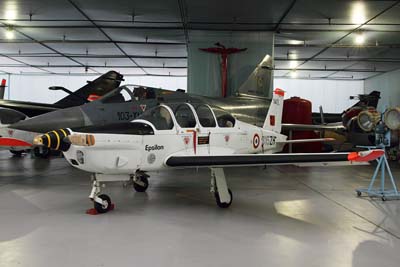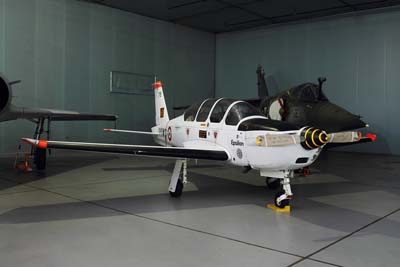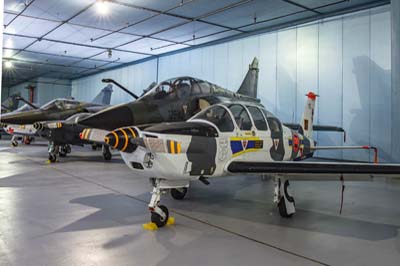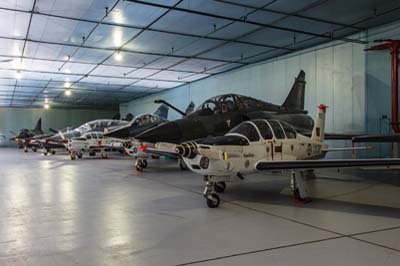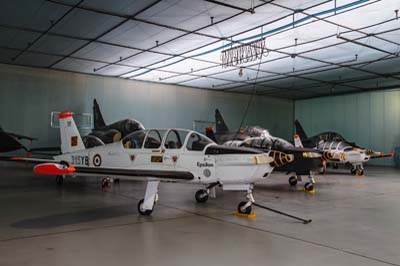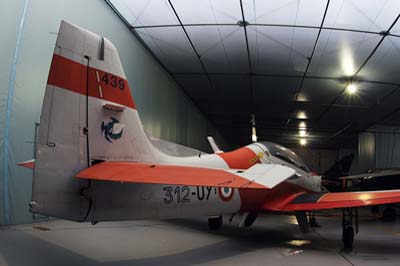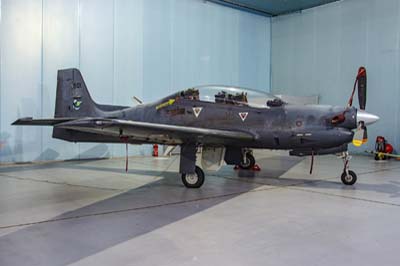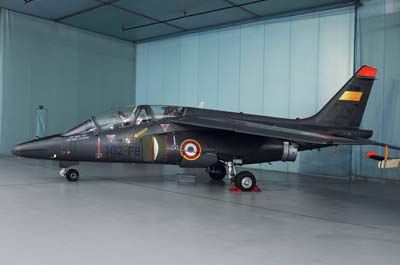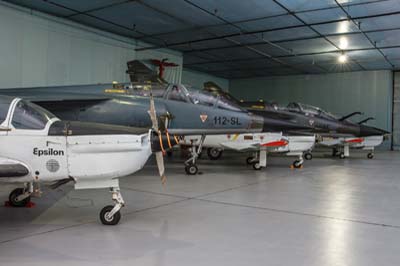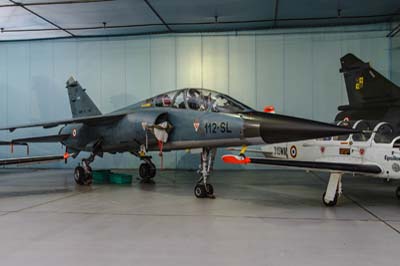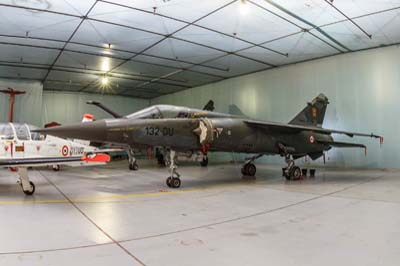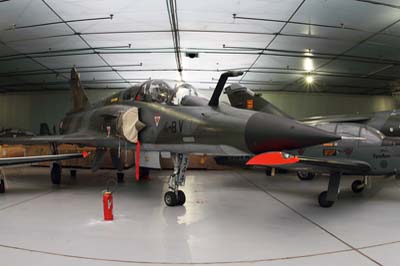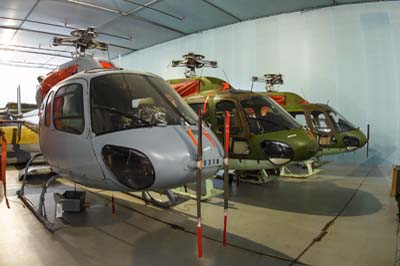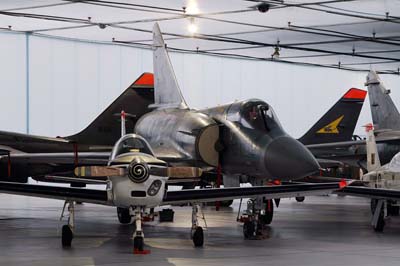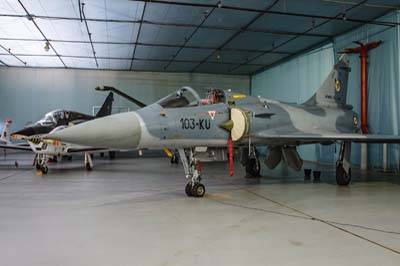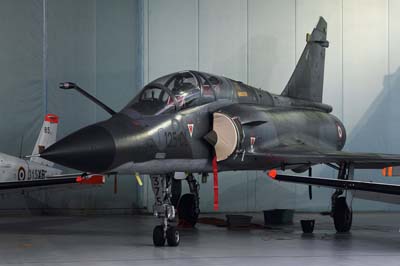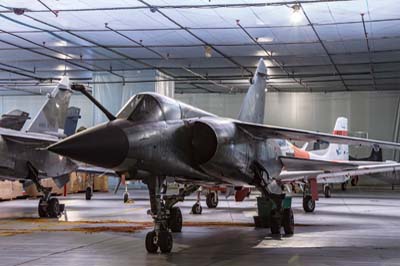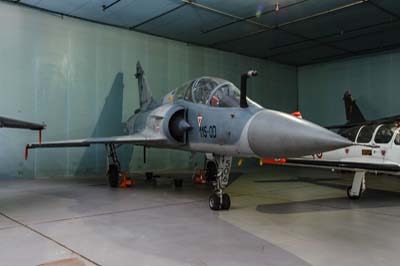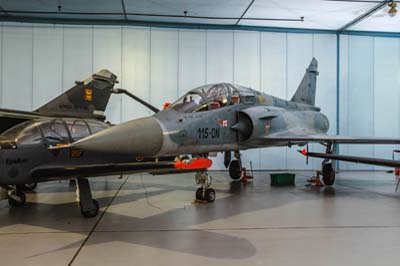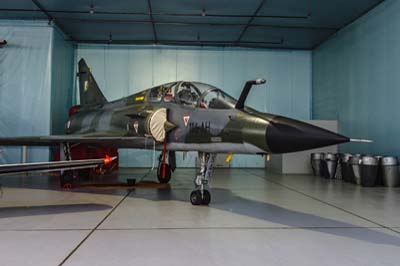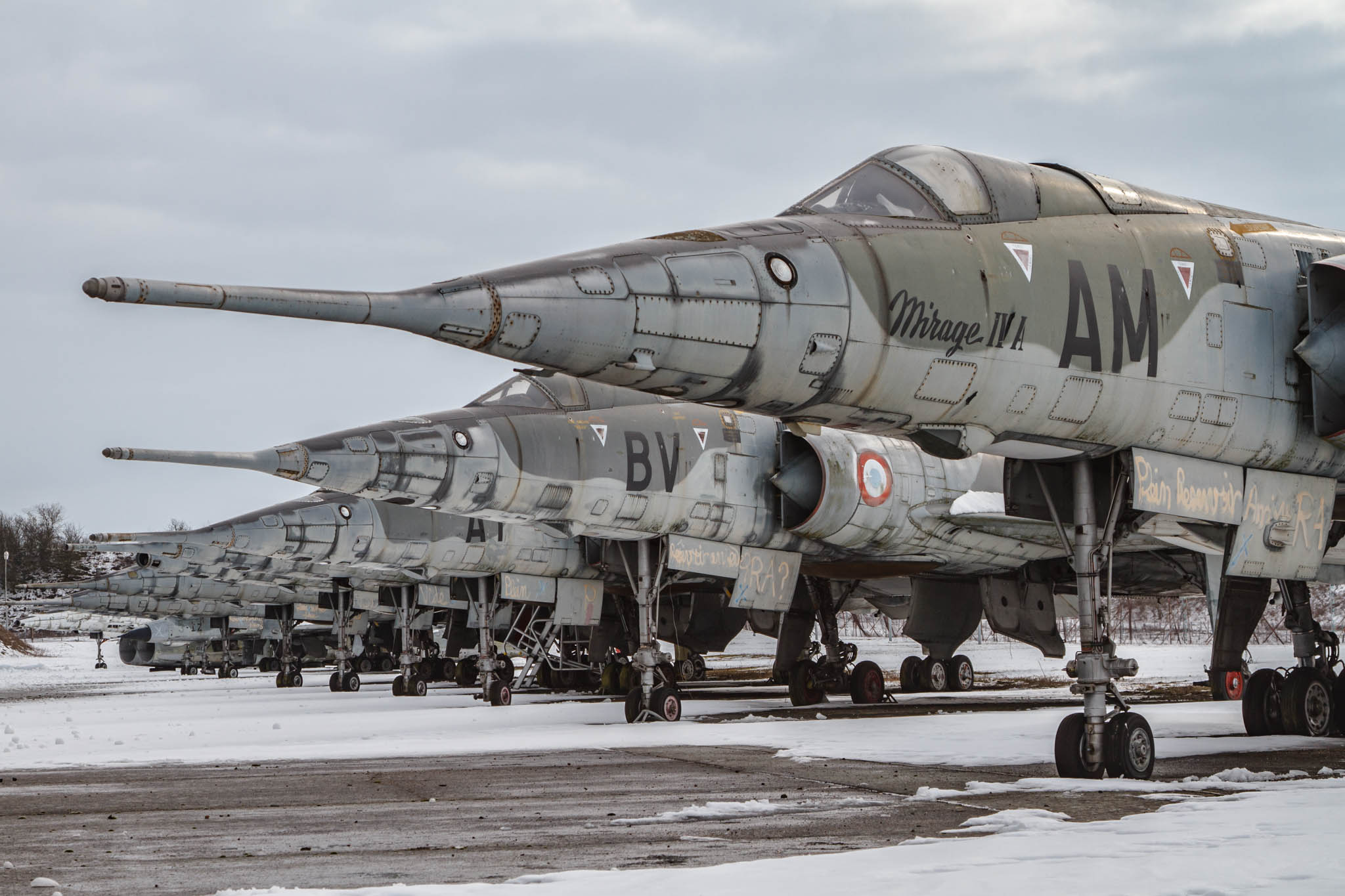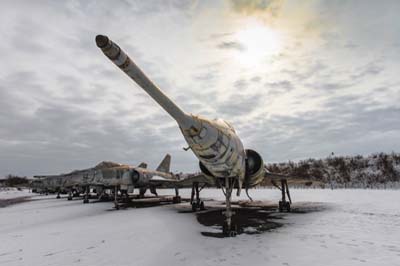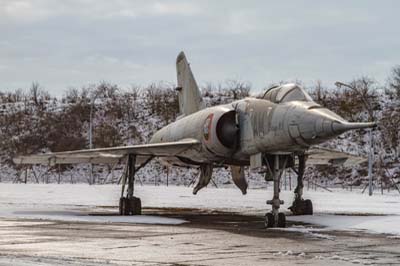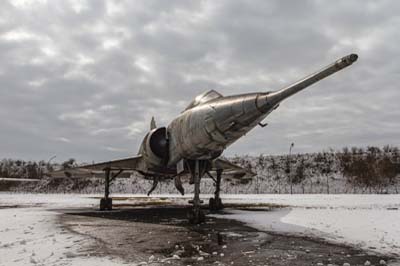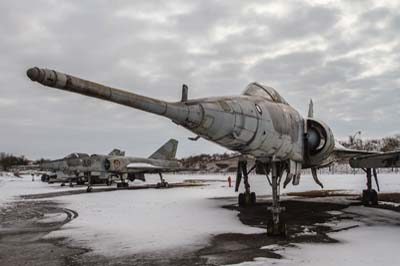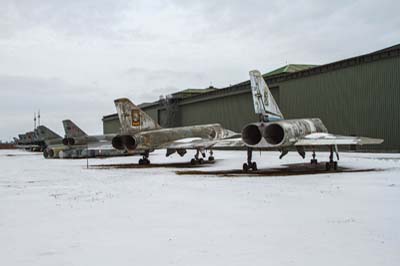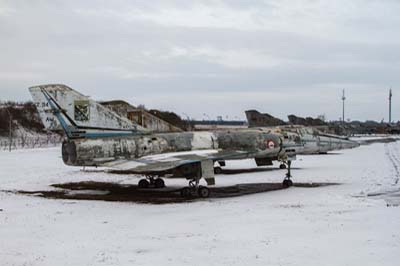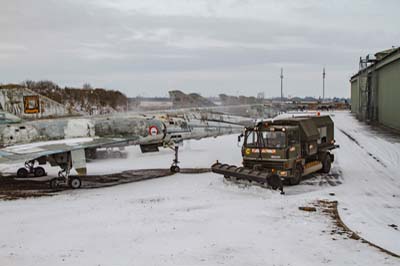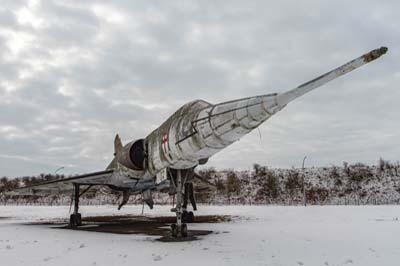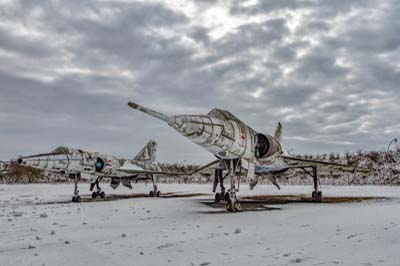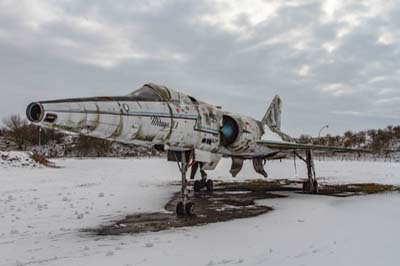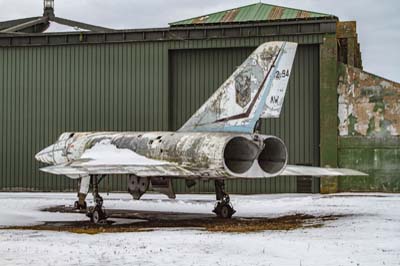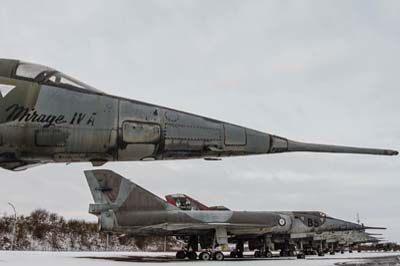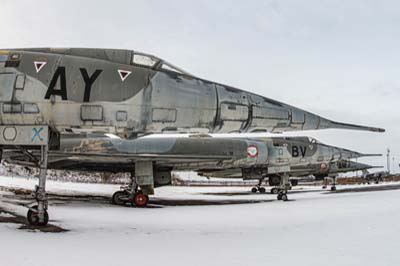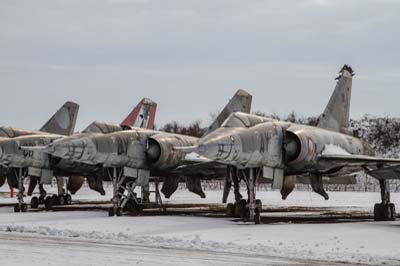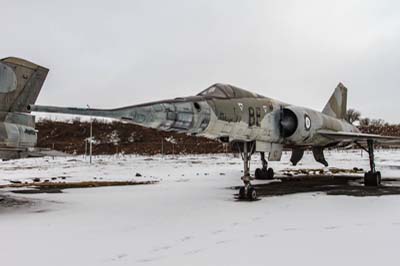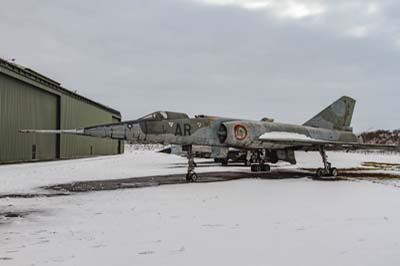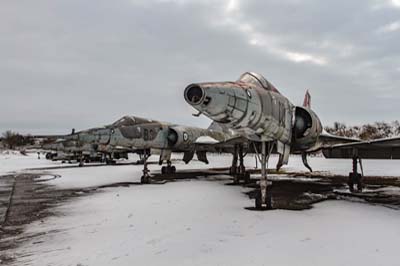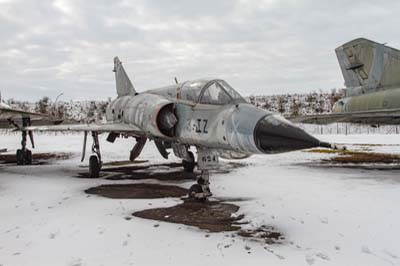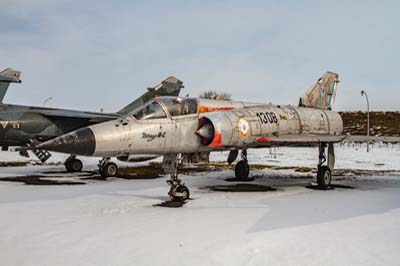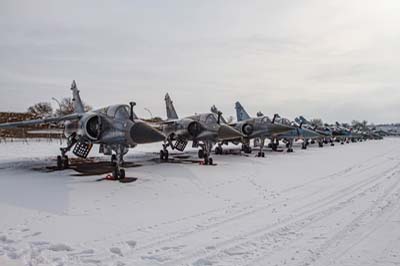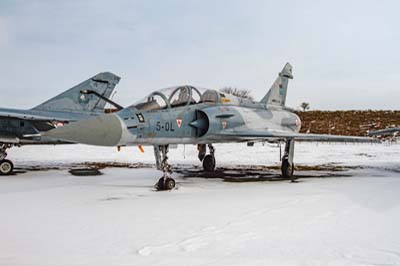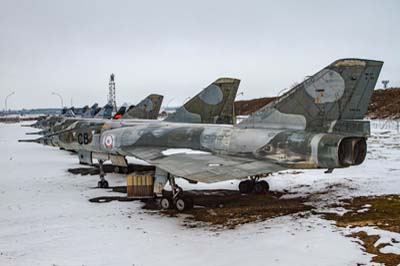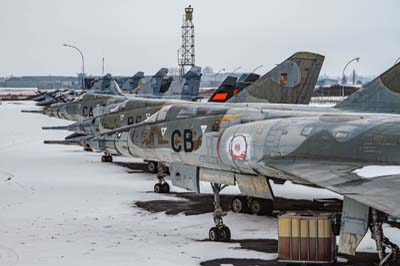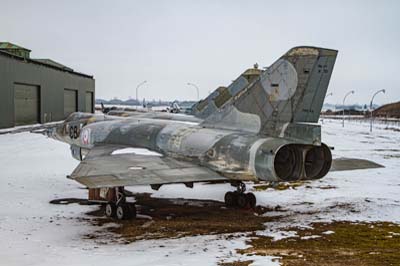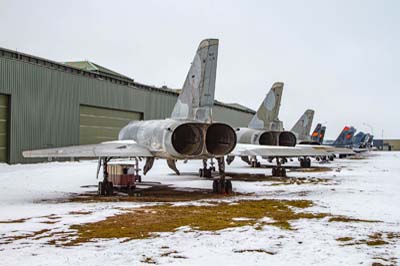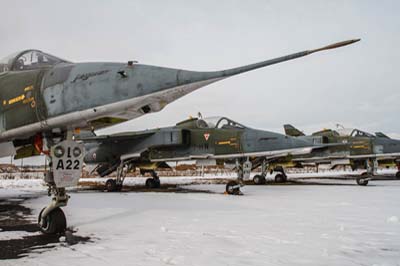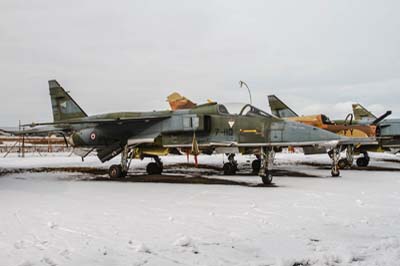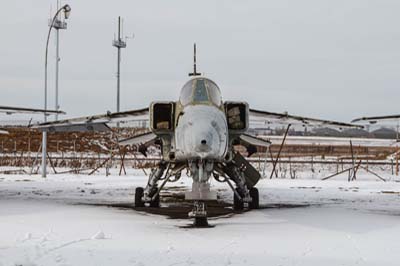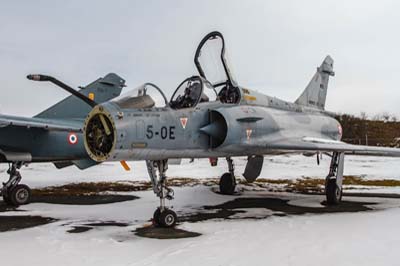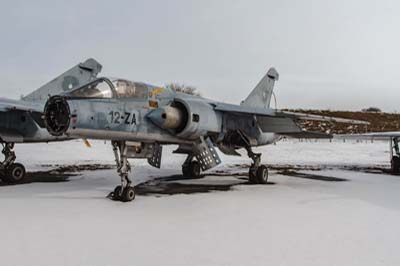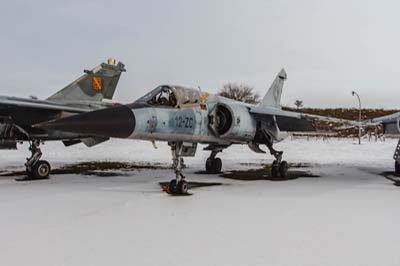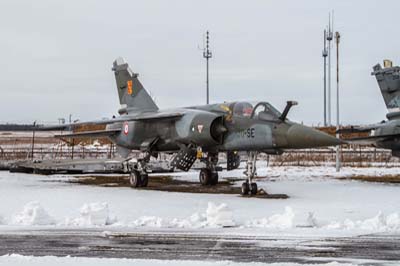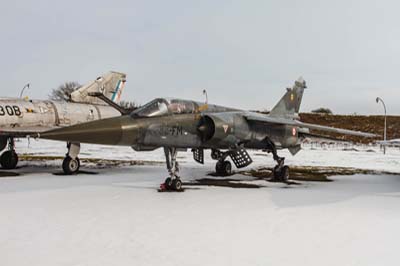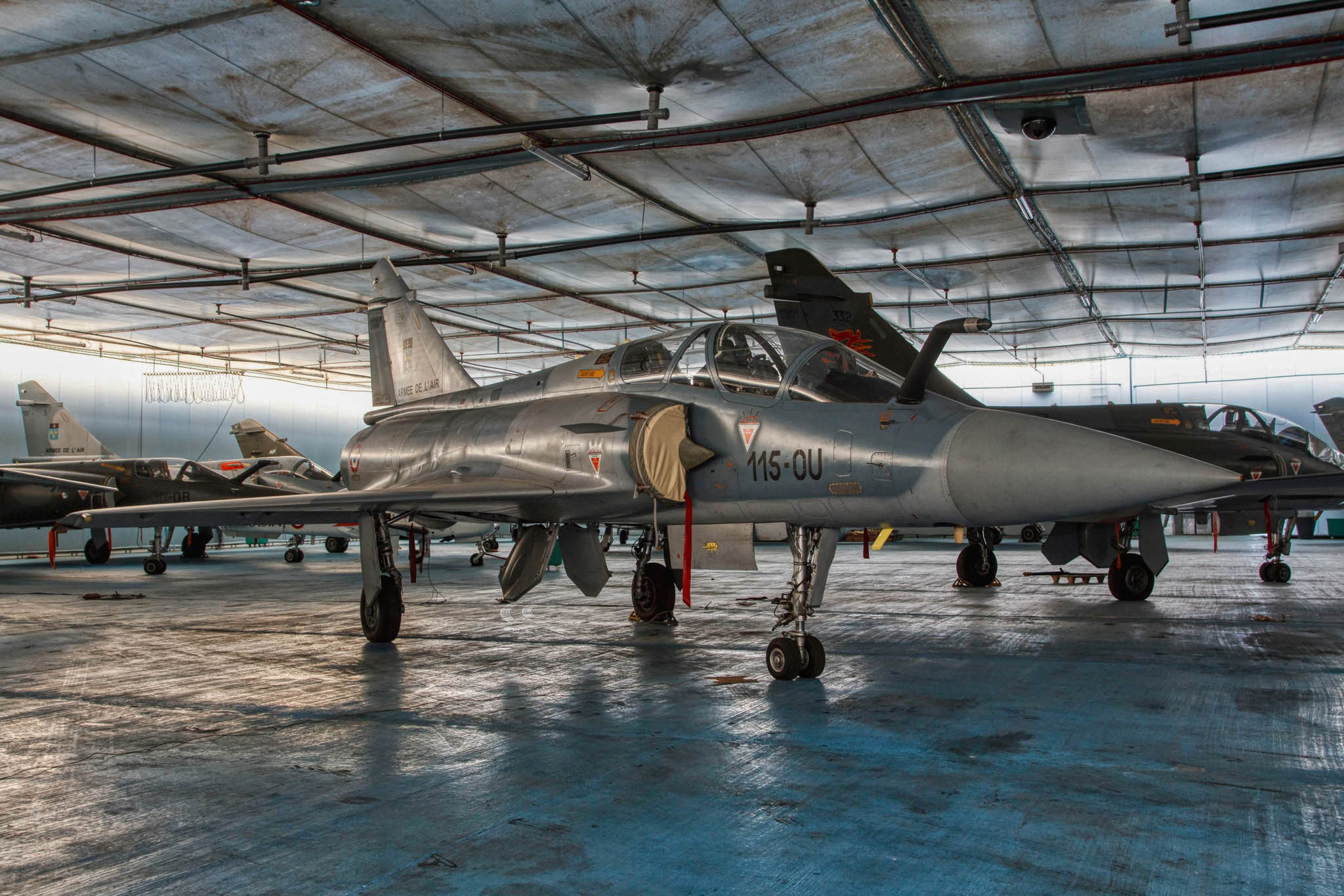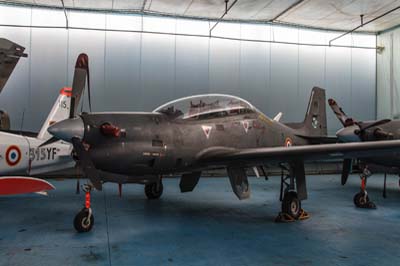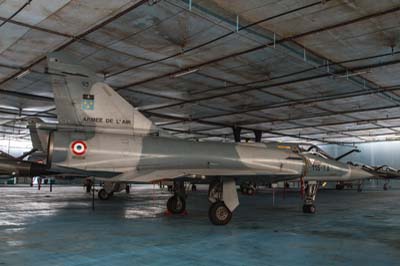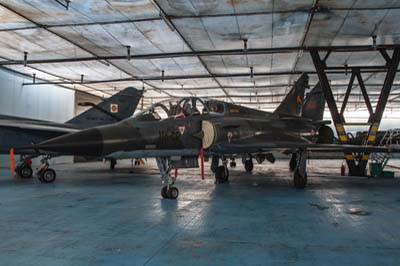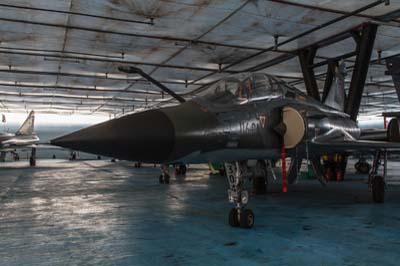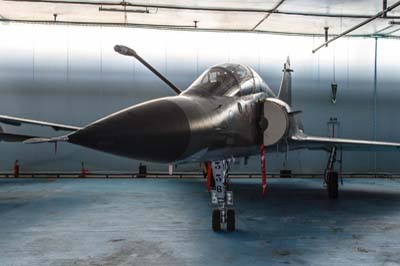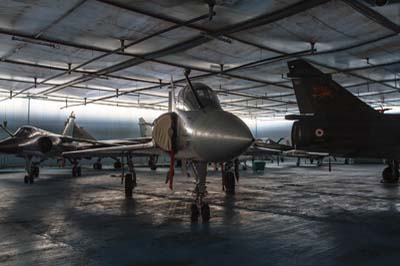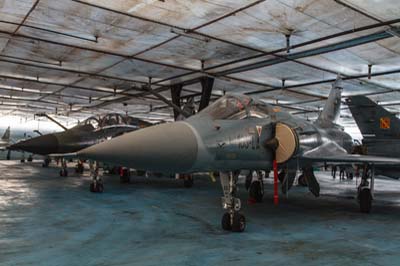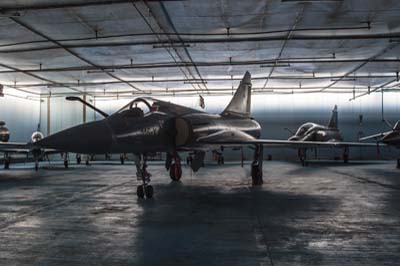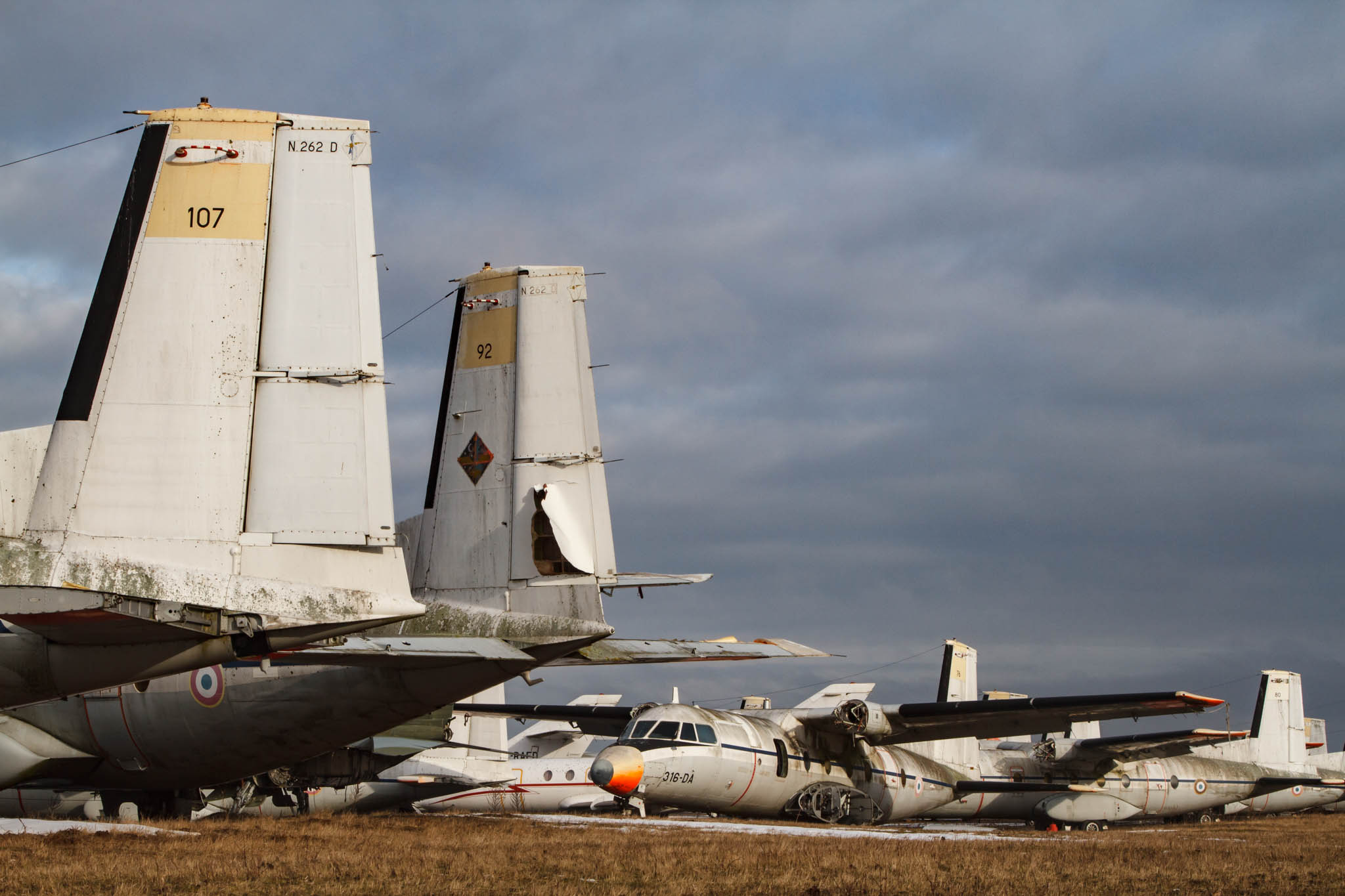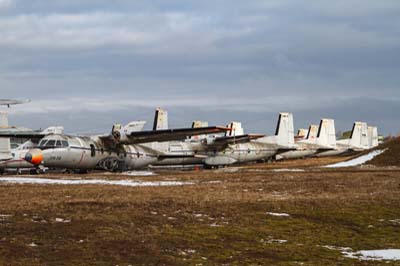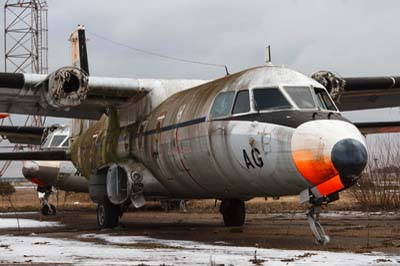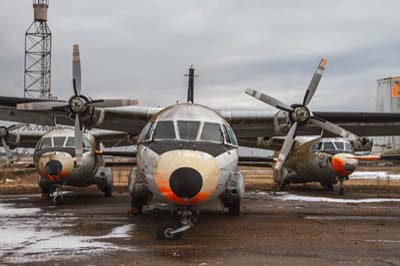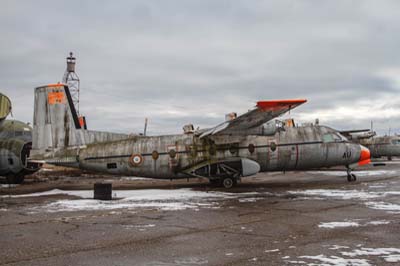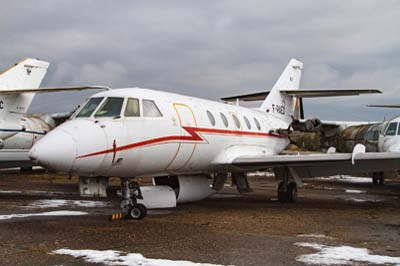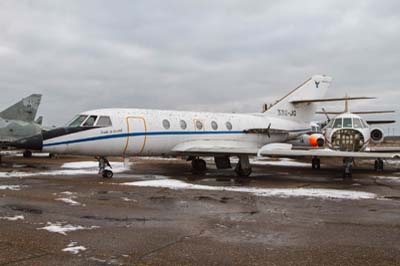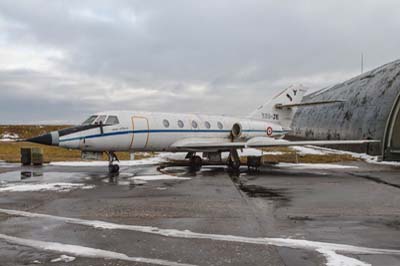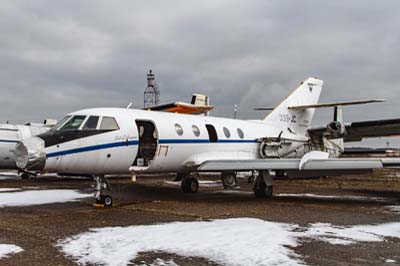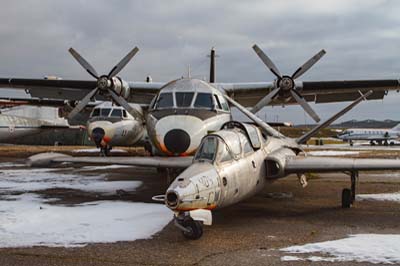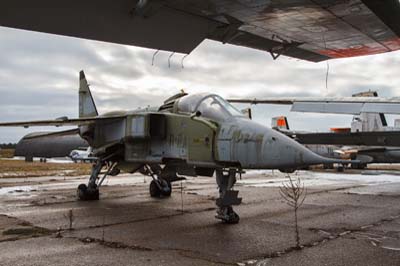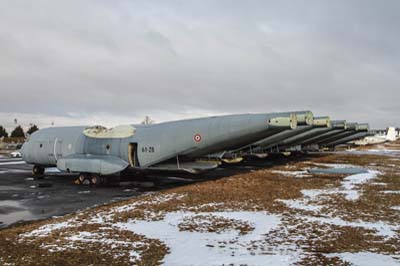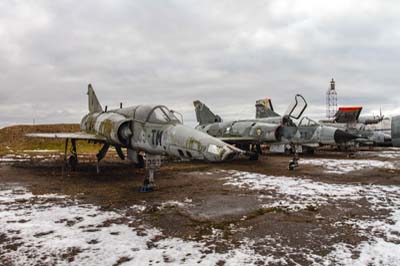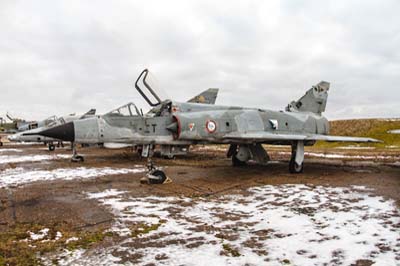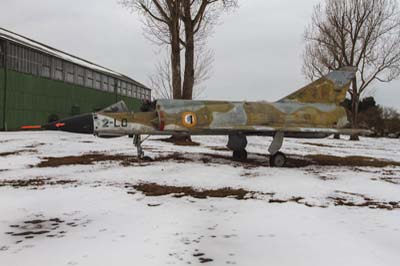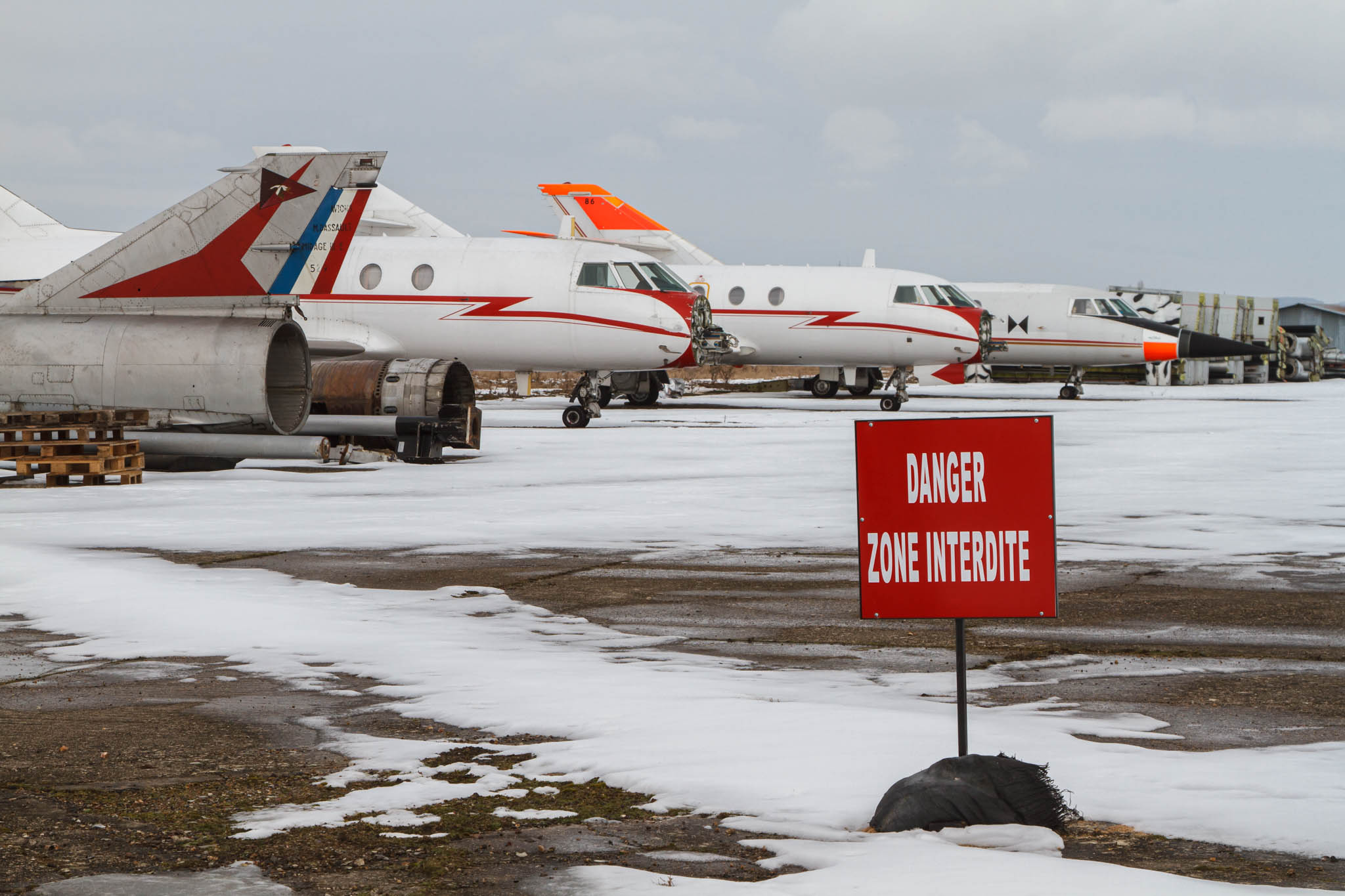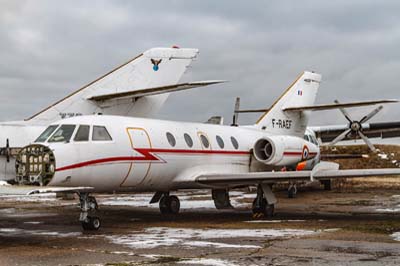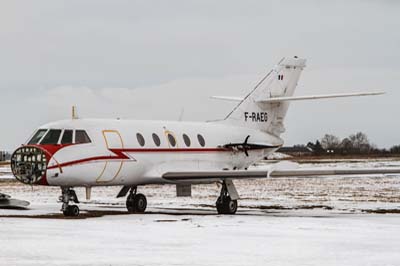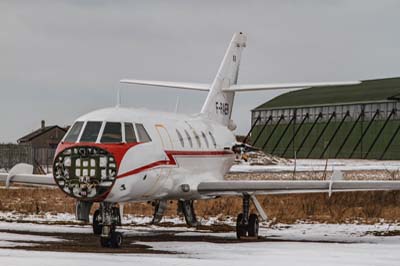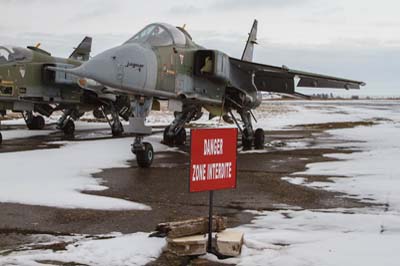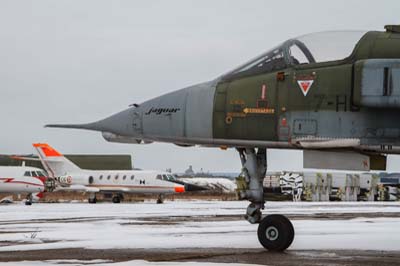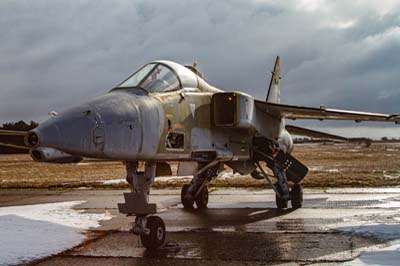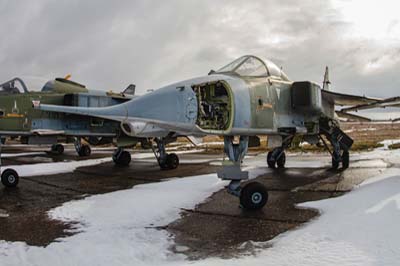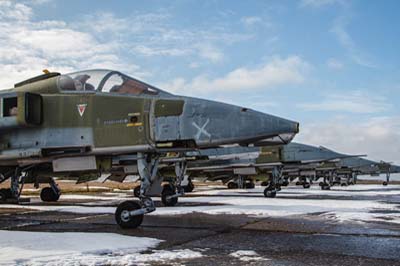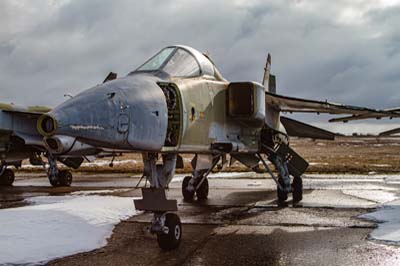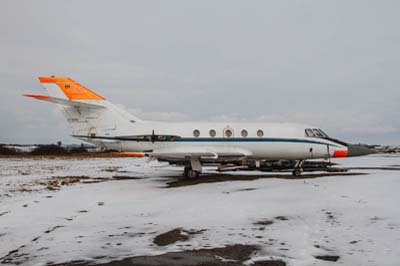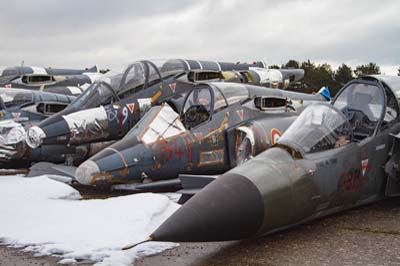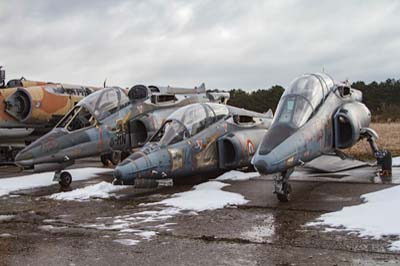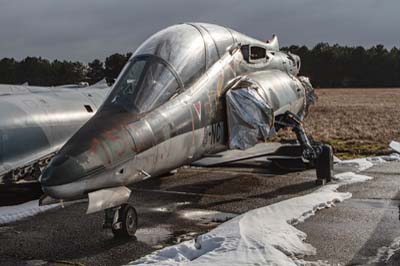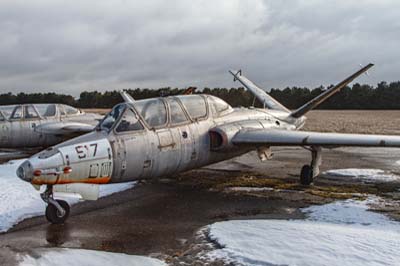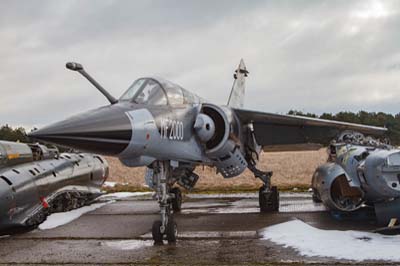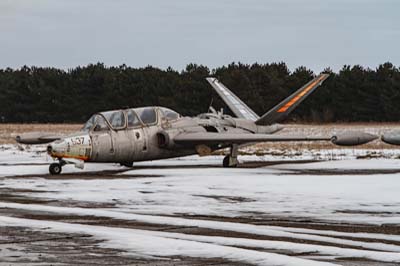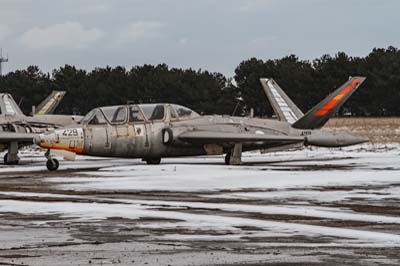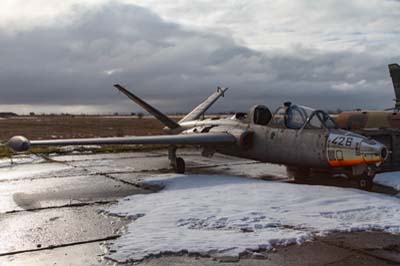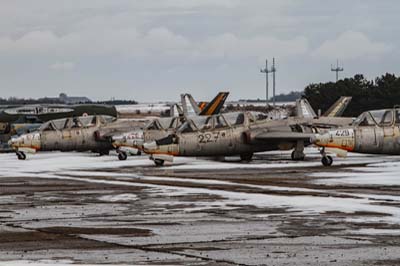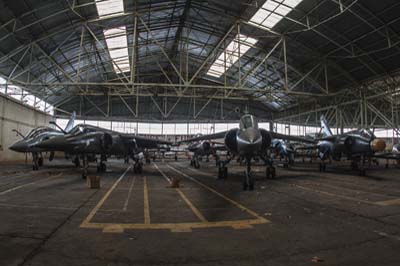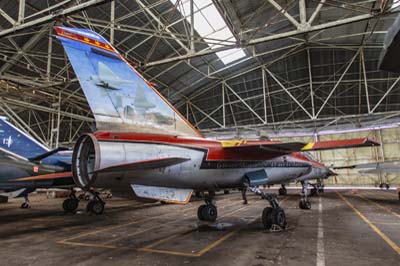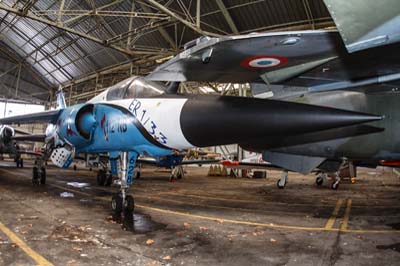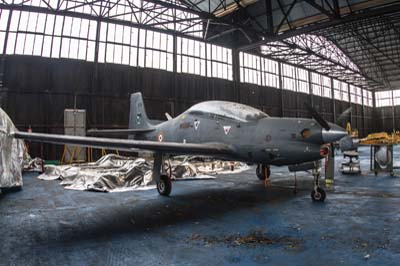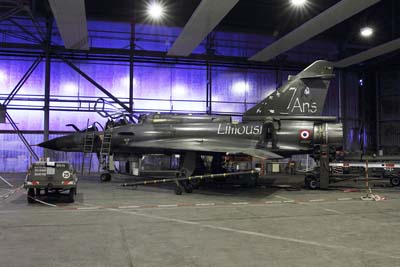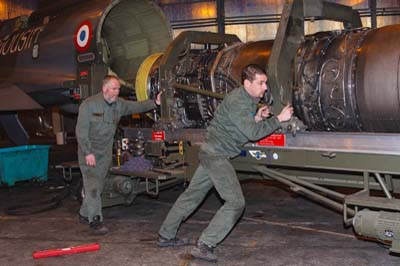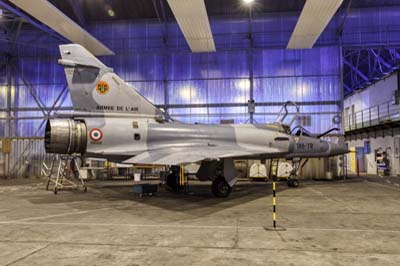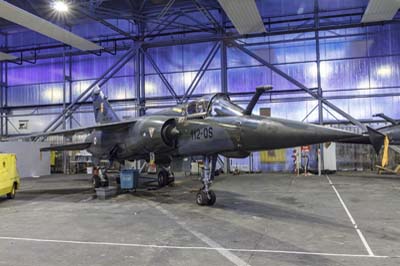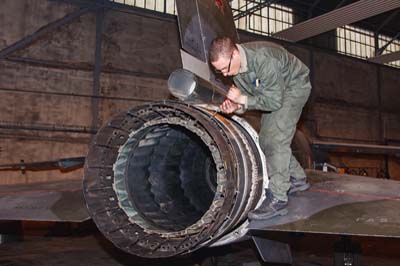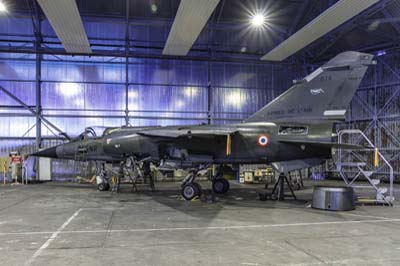Châteaudun - The French Air Force's Warehouse
Entrepôt de l'Armée de l'air 601 (EAA 601)
Groupe d'entretien de réparation et de stockage des aéronefs (GERSA 11.601)
Base Aérienne 279 Châteaudun
February 2012
|
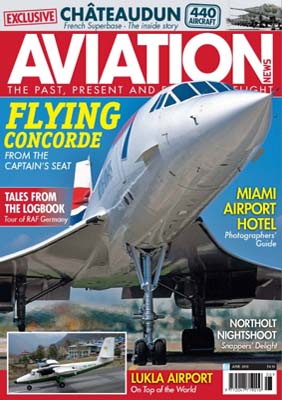 Philip Stevens reports for Aviation News from the largest storage facility in Europe.
Philip Stevens reports for Aviation News from the largest storage facility in Europe.
Châteaudun air base (Base Aérienne 279) the home of Entrepôt de l'Armée de l'air 601 (EAA 601 - French Air Force Warehouse). Formed in 1951 EAA 601 is the largest aircraft storage centre in Europe. It is essentially a Gallic version of AMARG (Aerospace Maintenance and Regeneration Group), but unlike Davis Monthan AFB in the dry Arizona desert heat, the Armée de l'Air (Adl'A) has to store its reserve fleet of aircraft inside climate controlled hangars awaiting a time when they are either returned to service or otherwise disposed of from the inventory.
Commandant (Cdt) Sylvain Lavignac, is the current Commander of 11.601 Aircraft Maintenance, Repair and Storage Group (Groupe d'entretien de réparation et de stockage des aéronefs - 11.601 GERSA), the principle host unit at Châteaudun. GERSA is responsible for the receipt, storage and dispatch of currently 440 aircraft, 194 of which are stored in humidity controlled hangars. Roughly half are unliekly to fly again. Among the types held on site are; Dassault Mirage F.1, Dassault Mirage 2000, Dassault/Dornier Alpha Jet, Socata TB 30 Epsilon and Embraer EMB-312 Tucano. |
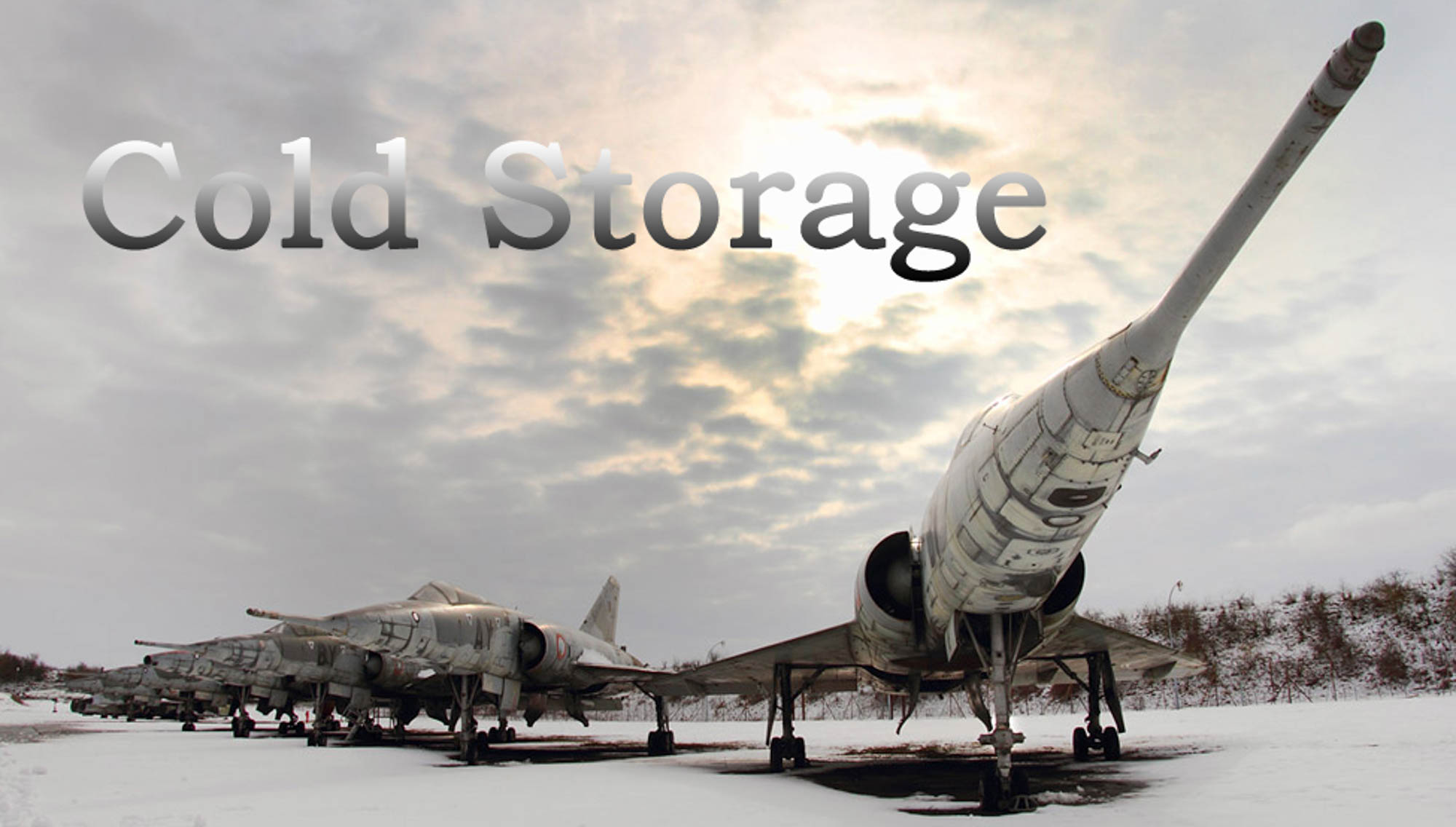 |
Left out in the cold: The French authorities have yet to make a decision on what to do with their long time retired Mirage IVAs and IVPs in open storage at Châteaudun some since the early 1990s. These former supersonic strategic bombers from the Cold War era first entered service in 1964 and were originally designed to carry the French nuclear deterrent. 21 aircraft were later modified to carry the ASMP medium-range nuclear missile, designated Mirage IVP (penetration) these entered service in 1986, the remaining IVAs were retired at this time. In 1996 its nuclear role was transferred to the Mirage 2000N. The twelve remaining Mirage IVP were modified for the reconnaissance role and served extensively in the 1999 Kosovo operation, five aircraft continued in service until 2005. Of the 62 Mirage IVs built 15 IVAs and IVPs are stored outside around the Poulmic storage hangar.
Above: Mirage IVP (49 'BV') heads a line up of twelve Mirage IVA/Ps. |
Facing new challenges
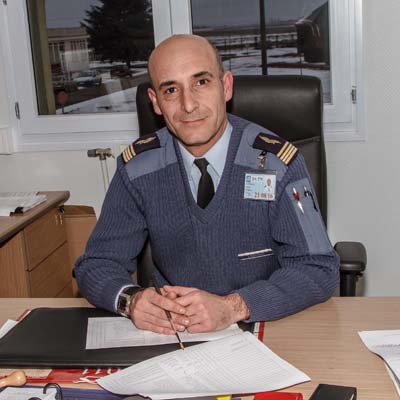 |
Commandant Sylvain Lavignac, Commander of 11.601 GERSA (Groupe d'entretien de réparation et de stockage des aéronefs) at his desk. Now one year in to the job is responsible for the maintenance, repair and storage of currently 400 plus aircraft, which will increase to 500 by 2015 following the French Government's rationalisation plan 'Air 2010'. |
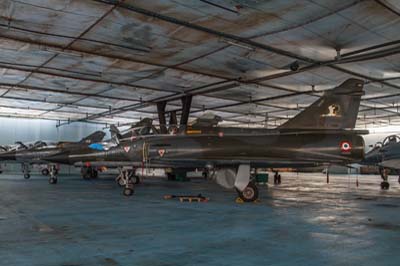 |
A Mirage 2000N (332 '116-BN') with a missing front cockpit glass which has been farmed to keep another Mirage 2000N flying. This aircraft is was one of the more recent arrivals it is previously based at Luxeuil-St.Sauveur (BA 116) when the Wing was disbanded in July 2011. The Mirage 2000N took over the nuclear strike role from the Mirage IV in 1996. The Dassault Rafale B was declared fully operational in the nuclear strike role in July 2010. |
Cdt Lavignac is currently twelve months into his posting at GERSA, having previously held a position at Orange air base (Base Aérienne 115). He is enjoying the challenge; "Here you can work on all the operational aircraft types in the air force; at Orange I was only working on the Mirage 2000C, here each aircraft has its own challenges." He is responsible for a skilled workforce including airframe, avionics and weapons specialists; "The most interesting aspect is the management of people, as the chief of the Air Force said, it is the men and women that make us a force"
Crucially, Cdt Lavignac also revealed that GERSA faces increased challenges over the next few years following the French Government's decision to rationalise the size of its fleet of military aircraft and the number of air bases it needs, this review was named 'Air 2010'. Cdt Lavignac has been told that he will have over 500 aircraft in his charge by 2015, as 'Air 2010' proposed that only 300 combat aircraft will be in service with the Adl'A by 2015.
Already numbers have started to increase as air bases are closed and units disband. Recent arrivals here have included at least 16 of the older Mirage 2000Ns from the former EC 01.004 unit which disbanded at Luxeuil (BA 116) in July 2011. The aircrew transferred to EC 02.004 when they moved to Istres (BA 125). Other recent arrivals are the Mirage F.1CRs from Reims (BA 112) which was closed in September 2011, some of its aircraft were transferred to Mont-de-Marsan (BA 118) the remainder were put into storage. 27 former BA 112 Mirage F.1B/CR/CT were noted in the GERSA hangars.
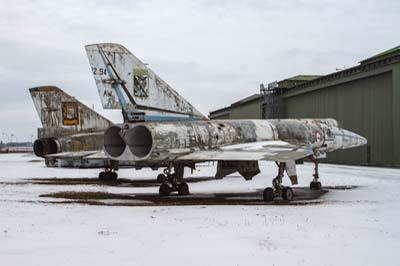 |
A line of the retired Mirage IVAs and IVPs outside the Poulmic hangar which contains at the time of the visit 111 aircraft plus another 83 at the Nivouville site are stored in climate controlled conditions of 45% humidity.
Heading the line is Mirage IVA (24 'AW') which is painted in the special markings of its final unit EB 2/94 'Marne' which were applied for the disbandment ceremony at St Dizier-Robinson (BA 113) on July 1, 1988.
Behind it is Mirage IVP No.7 (marked No.01 to show it was the first IVP conversion) which is painted in the special Mirage IV 25th anniversary markings which were applied in 1989 when with EB 2/91 'Bretagne' at Cazaux (BA 120), the unit disbanded in July 1996. Both aircraft have been parked at this location since around 1993. |
As Châteaudun has limited covered space of 98,425 Sq feet (30,000 Sq m) intense planning has been necessary to make sure they can accommodate the increasing numbers. GERSA work very closely with a unit at Bordeaux-Merignac (BA 106) known as Air Force Support Command (Commandement du Soutien des Forces Aériennes - CSFA). Established in 2008 CSFA has a staff of 21,500 and controls 300 military units. CSFA is divided into cells each responsible for an aircraft type, part of their responsibility is to manage the aircraft fleet's hours by rotating stored aircraft with those with the operational squadrons. They decide on which aircraft is put into storage and which is taken out, either to be returned to service or harvested for spare parts and ultimately scrapped. A plan is issued by CSFA every November which covers the movement of aircraft in and out of Châteaudun by aircraft type and for each month in the following year. Issued last November, the plan for 2012 shows that 40 aircraft will be added to the numbers in storage while only 20 will be taken out of storage.
Storing a sophisticated combat aircraft is no easy task, especially in a European climate. All the hangars available to GERSA are insulated with an inner lining of toughened plastic sheeting erected two meters or so from the outer wall. The sheeting is also suspended as a false ceiling above the aircraft.
The huge Poulmic hangar is the largest single storage hangar in Europe. Situated on its own in the south-eastern corner of the airfield, it is surrounded by revetments and trees with three lines of electrified barbed wire fences. Built in 1937 its modern metal cladding hides its original concrete and steel structure. Six industrial dehumidifiers keep the environment at a strict 45% humidity to prevent damp air from corroding the aircraft's sensitive components. Smoke alarms, water sprinkler systems and close circuit television cameras linked to the fire service complete the security deemed necessary to protect a large proportion of the nation's air force. At Poulmic Corporal Cheron is one of four electrical technicians who are solely responsible for maintaining the safe environment for the hangar's inmates. He opened a side door where a sign warned that mobile phones must be left outside apparently the electro-magnetic radiation they emit is a potential cause of combustion. Once through an air-tight door and in to the first of three inner cells a strong smell of aviation fuel was very apparent. A light switch was thrown and the dark shapes we could see were revealed to be long lines of assorted Adl'A aircraft.
Another two pairs of storage hangars are located in the south-western corner of the airfield which form part of the Nivouville site named after the nearest village. These hangars also house a mix of Mirage 2000 variants, Mirage F.1, Alpha Jets and Epsilon along with a section with aircraft drop tanks. These hangars are also lined and are humidity controlled (Enceintes à Hygrométrie Contrôlée - EHC). The author's visit coincided with challenging weather conditions with extreme cold and snow. As the snow began to thaw you could hear water continually dripping on to the blue plastic sheeting above the aircraft, a network of pipes allows the water to drain away. Six hardened air shelters dispersed around the field we were told also hold aircraft in storage.
North side of the single 7,552 foot (2,302m) runway are three more pairs of hangars. One hangar contains aircraft which have been involved in accidents which have been transported here for investigation by an external authority. Another hangar contained aircraft that had recently arrived and were waiting the attention of the GERSA technicians along with a number of retired aircraft which are being used as a source of spares.
As covered space is at a premium we currently have 246 aircraft stored outside at various points around the airfield. These have in the main been harvested for spare parts. One of the main storage areas is the southern end of the disused cross runway known as the "German runway." At its southern end there are over 50 forlorn looking airframes in various stages of dismantlement including; Mirage 2000C/N, Mirage F.1, Alpha Jet, Sepecat Jaguar, Fouga CM.170R Magister and the fuselages of 13 former French Navy (Aeronavale) Nord 262E transports the last of which flew in 2009. Outside at the nearby Nivouville site are another 19 Nord 262D Frégate which had operated with the Adl'A up to 2004. With these sorry looking aircraft are some eleven wingless Transport Allianz C-160F Transall and half a dozen or more Dassault Mystère 20. Some of these aircraft will linger on for a decade or more; others won't be so fortunate and will go to the melting pot. |
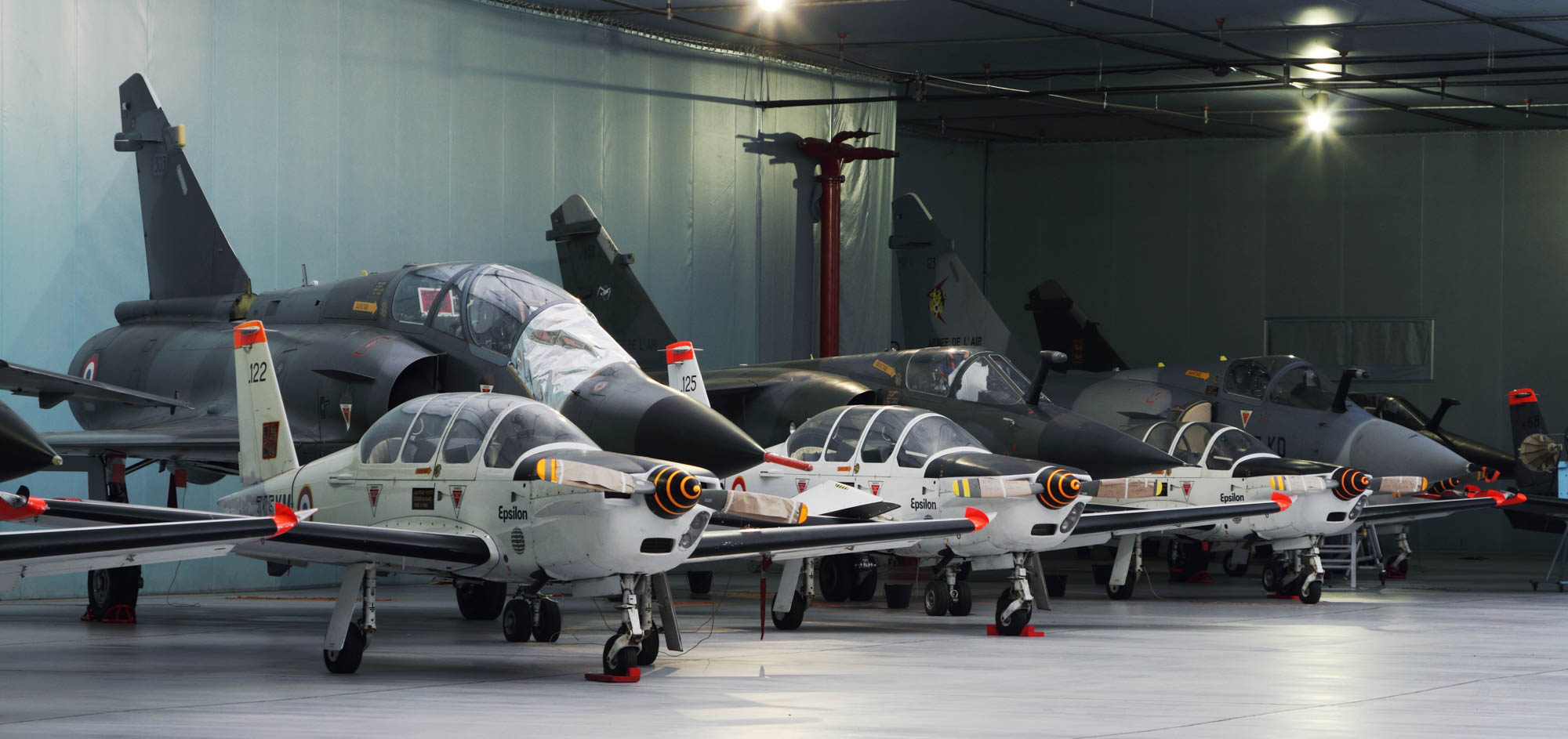 |
| Inside Poulmic hangar Epsilons fill in the gaps between the Mirage 2000s and Mirage F.1s |
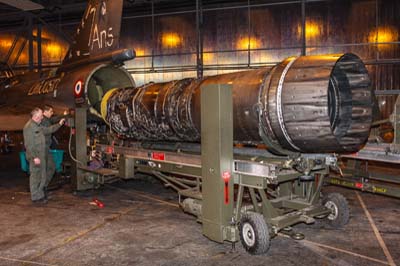 |
Mirage 2000N (360 ‘125-CB’) had arrived from Istres air base a few days ago. GERSA technicians remove all engines before an aircraft is put into storage and return them to their former home base. |
Preparing an aircraft for storage
When an aircraft arrives for storage it is transferred in to the main GERSA hangar the following day. Accompanying the aircraft will be its detailed technical maintenance and service record. “We don’t become the ‘owner’ of the aircraft without these records. The technical documentation advises us what work or maintenance we need to do on the aircraft”, explained Cdt Lavignac. The large GERSA hangar is divided in to three cells; the first cell is where aircraft are stripped down. A ‘zone de demantelement’ is created and three teams of specialist technicians descend upon the aircraft. The avionics team work on the electrical equipment including the Radar, the weapon systems and the hydraulic systems experts have their own tasks to perform. Weapon’s systems and the ejector seat(s) are all removed. The engine is taken out to be returned to the aircraft’s operational air base where it will be used to keep the unit’s other aircraft flying. The aircraft’s fuel tanks and hydraulics are then filled to 90% capacity to ensure these systems do not leak during its time in storage.
The aircraft will be held in storage for at least one year and often for two years or even more in some cases. Aircraft manufacturers have stated that an aircraft can be in storage for a maximum of two years, after which time it has to be returned to full flying order. After flight testing at Châteaudun it can be returned to storage for up to another two years assuming it is not required by an operational unit. After four years a Mirage 2000 for example will require ‘major’ maintenance which is carried out at the Industrial Workshop of Aeronautics (Atelier Industriel de l'Aéronautique - AIA) at Clermont Ferrand before it can be returned to storage. Each aircraft type is different noted Cdt Lavignac; “The Mirage F.1 creates the biggest problem for us, it has a tendency to leak due to its age. In contrast the Alpha Jet is an easier aircraft to store as its simple technology is easy to maintain”.
Returning aircraft back in to service
It is not a simple process to return a stored aircraft to flying order; some aircraft will have had parts removed from them during their time in storage to keep other aircraft flying. The administrators will keep track of which parts have been taken from a particular aircraft. One month before an aircraft is to be removed from storage a list is produced of all missing parts which need to be recovered from other stored aircraft. “It’s like a game you take it from one to put it in another, you gather the missing parts from as few as aircraft as possible”, explained Cdt Lavignac. The process is also made more complicated when during the storage period there may have been modifications or updates which now need to be applied. “Every day we have a meeting which we call the ‘mess’ with the chief of the exploitation division to resolve technical and logistical problems with every aircraft we are working on”, explained Cdt Lavignac, adding; “There is no set time to prepare an aircraft for flight, it depends on the amount of missing parts and the number of modifications and updates”. Typically it will take between three and five weeks to return an aircraft to the air, the process involves a team of technicians from each specialty; mechanical using three technicians and avionics with two to three technicians. At the end of the operation one or two weapons experts will complete their tasks, the fitting of the ejector is the last job. GERSA are trained to work on ten types of aircraft (Mirage 2000D, N, C/-5 and B, Mirage F.1B, CT, CR, Alpha Jet, Epsilon and Tucano). A limiting factor as to the amount of aircraft that can be worked on at any one time is the availability of Crew Chiefs who each manage a team to bring an aircraft back into flying order, for example there are only three Mirage F.1 Crew Chiefs at GERSA. An engine run is all that is required for restored aircraft before they are handed to the ferry pilots, with the exception of the Alpha Jet which requires a test flight before ferrying.
Pickup and drop, the Châteaudun “Taxi service”
One week before completion the Escadron de Convoyage (EdC) 00.070 ‘Châteaudun’ will be informed that an aircraft will require ferrying to its squadron. Based at Châteaudun EdC 00.070 has six pilots who ferry all Adl'A aircraft from and to Châteaudun and between maintenance centres and air bases. It is the only squadron dedicated to ferry pilots and aircraft around France.
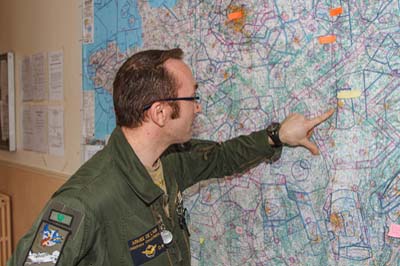 |
Cne Chaintreuil has been with EdC 00.070 for four years ferrying pilots and aircraft between air bases and maintenance centres. “We plan the ferry flights for the optimum route. We also have to be very flexible as an aircraft can have technical faults at the last minute”. |
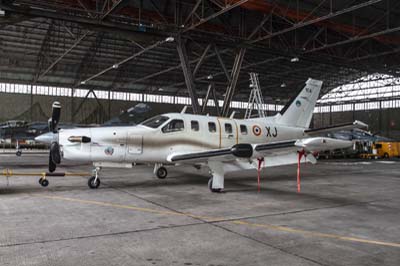 |
The TBM-700A (104 ‘XJ’) is assigned to the ‘Châteaudun’ convoy squadron (EdC 00.070) it is economic and fast it can take-off and land on short runways. Apart from the pilot there are five places for passengers plus it can carry 330 pounds (150 kg) of cargo. Each ferry flight will include a chest with the aircraft’s documents which because of its size may require a seat to be removed. |
Captain Stephane Chaintreuil a former Lockheed C-130H Hercules pilot has been with EdC 00.070 for four years he explained their operations; “We have three fighter pilots and three airlift pilots, in the busiest days we can move four to six aircraft from one base to another. I can fly our own Socata TBM-700A and the Epsilon”. As the squadron does not have any navigators the transport pilots fly in the back seats of the Mirage 2000D and N to operate the switches. “This is very interesting for the transport pilots we will fly 30 to 40 hours a year in the back seat”, said a smiling Cne Chaintreuil.
The three fighter pilots can fly the complete range of ten or so types stored at the air base. New EdC 00.070 pilots go to the test pilot school to do two or three flights to get an overview of the flight characteristics of each aircraft. Cne Chaintreuil explained; ”It is easy to stay current on all the types we fly as the missions are quite simple, our aim is just to fly an aircraft from one base to another. The flights are not complicated as it is basic navigation”. There is some latitude for these ferry flights, although they have to be as straight as possible to save fuel and to keep flying hours to a minimum, they can fly at low-level if weather permits and there is low risk of bird strike.
The experienced Cne Chaintreuil is clearly enjoying his time with EdC 00.070; “Pilots at the ‘Châteaudun’ squadron choose to come because of the different types of aircraft we can fly. This could be our last flying job in the air force”. Pilots will stay with EdC 00.070 for between three and five years some as long as twelve years. Cne Chaintreuil described a typical tasking; “I could take-off from Châteaudun at 08:30 and fly to Clermont Ferrand with our three fighter pilots, two for a flight to Nancy in a Mirage 2000D. I could then take the other pilot to Istres for him to pick up an aircraft bound for Clermont Ferrand. I would then fly north to Nancy to pick up our pilots and ferry them home to Châteaudun”.
To plan these ferry flights all the Adl'A squadrons are linked to a dedicated office at Châteaudun known as the aircraft movement regulation desk (Bureau de la régulation des mouvements d'aéronefs – BRMA). BRMA collate all the requests and inform EdC 00.070 of the aircraft that need to be moved. “We then plan the ferry flights for the next two days for the optimum route. We also have to be very flexible as an aircraft can have technical faults at the last minute”.
Protecting the nation’s heritage
A number of aircraft are scrapped here each year under contracts with private contractors which are administered by the CSFA. Civilian rules regarding identification of materials and how it can be disposed for environmental reasons apply. Guided by the Adl'A's headquarters aircraft can be saved from the melting pot. Cdt Lavignac does recognise the need to preserve aircraft for the nation. “We liaise with civilian associations who want to take aircraft from here to their museums. Staff from approved museums will come here two or three times a year to take pieces off aircraft to help with their restorations”.
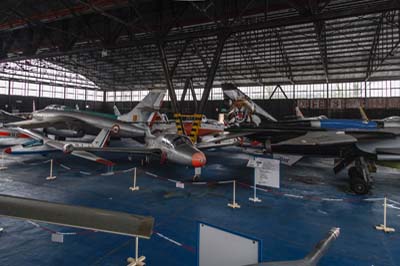 GERSA also enjoys a close relationship with the on base museum which is situated in a hangar on the northern side. The Conservatoire d'Aéronefs Non Opérationnels Préservés et Exposés (CANOPEE) museum was officially opened in 2006 and houses a collection of around 50 former Châteaudun inmates from previous decades. Unfortunately, the museum is not currently open to the public.
GERSA also enjoys a close relationship with the on base museum which is situated in a hangar on the northern side. The Conservatoire d'Aéronefs Non Opérationnels Préservés et Exposés (CANOPEE) museum was officially opened in 2006 and houses a collection of around 50 former Châteaudun inmates from previous decades. Unfortunately, the museum is not currently open to the public.
Pressed to name a favourite aircraft in his charge, Cdt Lavignac does keep a watchful on eye on the 15 or so stored Dassault Mirage IV’s which have evaded scrapping since the last Mirage IVPs were retired in 2005. “I have affection for the Mirage IV it was the first aircraft I worked on when I was a young Sergeant and Radar specialist. It is a really beautiful aircraft”. Examples of the former supersonic strategic bomber and reconnaissance platform are currently stored outside around the Poulmic hangar. Although a number of Mirage IVA/P are already preserved in France, hopefully a few more will find a new home. However, there are no immediate plans to move them on at this time. I am sure Cdt Lavignac given the chance would like to take one home for himself! |
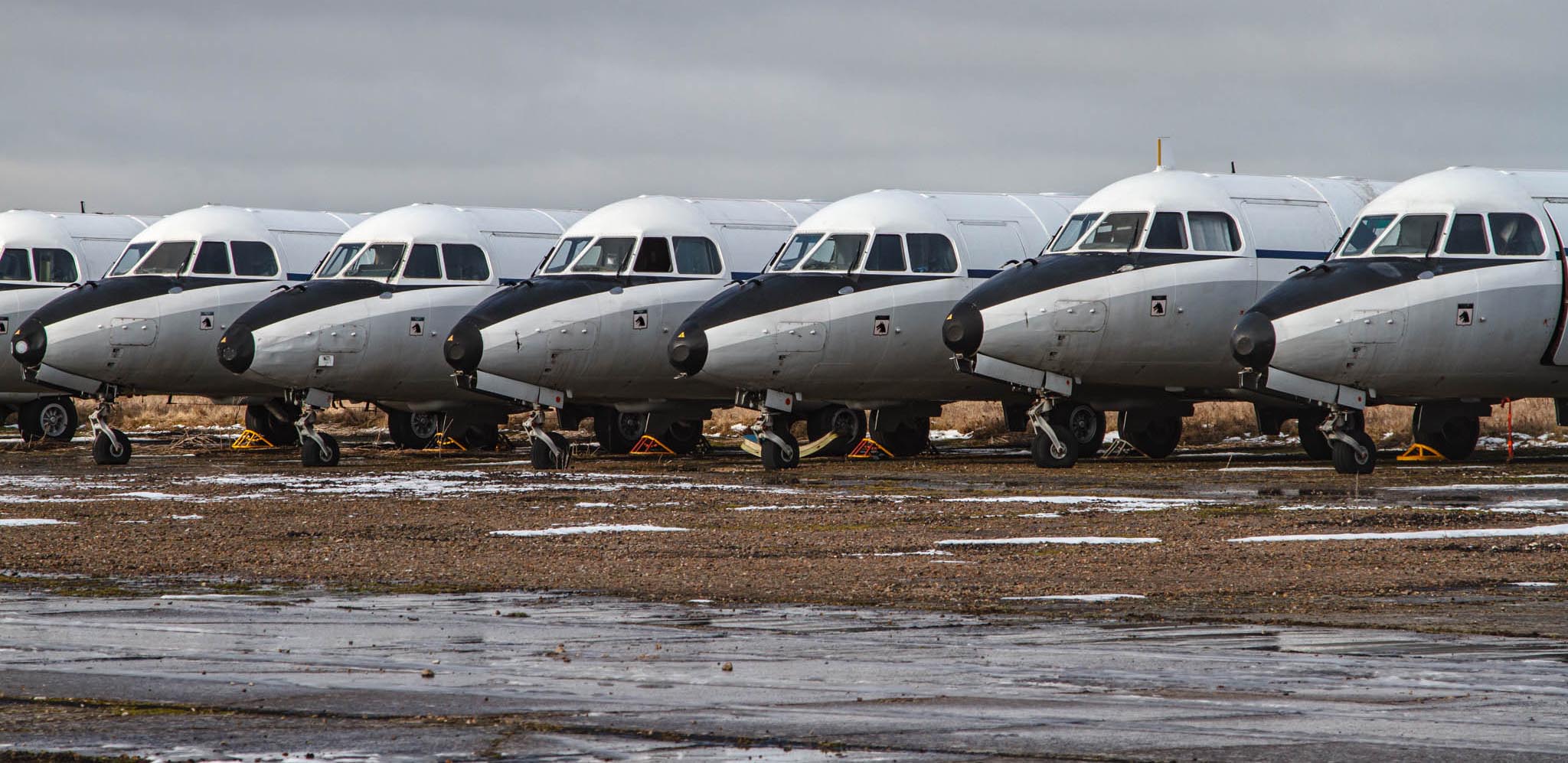 |
| Former Aeronavale (French Navy) Nord 262E transports the last of which flew in 2009 are on the German runway minus their wings and tails, they were originally delivered to the Adl'A from 1967. |
Left to right:
Mirage 2000C (79 ‘115-LE’) arrived at Châteaudun after its long journey by road 1,900 mile (3,060 km) from Lithuania, it had been involved in a mid-air collision with a Lithuanian Air Force Aero L-39ZA Albatross during a training exercise on August 30, 2011. The crew of the L-39ZA lost control of their aircraft and were forced to eject.
Deliveries of the Mystère 20 began in the mid 1960s while some were retired between 2005 and 2007 the Flight Test Centre (Centre d'Essais en Vol - CEV) Mystère 20s which have been modified for various trials over the years continued in service till 2009 when No.86 'CG' was flown to Châteaudun.
Former Aeronavale (French Navy) Nord 262E transports the last of which flew in 2009 are on the German runway minus their wings and tails, they were originally delivered to the Adl'A from 1967.
Alpha Jets litter the German runway, these retired airframes are being harvested for spare parts to keep the remaining fleet in service until an expected date of 2015. |
Left to right:
Mirage 2000D (612 '133-JK') from BA 133 Nancy-Ochey but deployed to Kandahar in Afghanistan has recently returned following a crash about 60 miles (100 kilometres) west of Farah on May 24, 2011. It was flying with a Mirage F.1CR in support of Italian Forces engaged with insurgents. Both crew ejected safely and were unhurt. The accident is presumed to be due to technical reasons but will be investigated.
Mirage F.1CR (643 '118-CE') from ER 02.033 at Mont-de-Marsan (BA 118) has just arrived at GERSA for storage, returning from strike/reconnaissance operations in Afghanistan it has 30 mission marks beside the cockpit. The Mirage F.1 is expected to remain in service with the Adl'A until 2014.
A Mirage F.1CR (662 '112-NF') in one of the climate controlled storage hangars on the Nivouville site. It has more recently arrived from Reims-Champagne (BA 112) which was closed in September 2011. Due to its age and its tendency to leak the Mirage F.1 gives GERSA the most problems.
Outside the Battle Damage Repair unit (L'Equipe d'études techniques de réparation des dommages dus au combat - EETRDC 64.600), some of their aircraft including; Jaguar A, Mirage 2000C, Mirage F.1C and a wingless C-160 Transall. Formed in 1982 the EETRDC comes under the command of the CSFA at Bordeaux. Its mission is to find fast and simple methods for repairing aircraft damaged in combat and to offer training to other units on these techniques. |
Around Base Aérienne 279 Châteaudun
Inside Poulmic hangar |
| Poulmic hangar contained 111 aircraft divided in to three cells, a water sprinkler system is fitted above the aircraft. |
| Left to right: TB.30 Epsilon (21 '315-UT', 143 '315-ZH', 76 '315-WS' and 61 'F-SEWD' in a special paint scheme) all previously with EPAA 00.315 from Cognac-Chateaubernard (BA315). |
Left to right: TB.30 Epsilon (153 '315-ZP' and 111 '315-YB') previously with EPAA 00.315 from Cognac-Chateaubernard (BA315).
EMB-312F Tucano (439 '312-UY') in the original Tucano markings when with PNAA (École du Personnel Navigant de l'AdlA) 05.312 at Salon de Provence (BA 701). |
Left to right: EMB-312F Tucano (501 '312-UT') previously with EPNAA (École du Personnel Navigant de l'AdlA) 05.312 at Salon de Provence (BA 701).
Alpha Jet E (E86 '102-FB') of EE 02.002 based at Dijon-Longvic (BA 102).
Mirage F.1B (510 '112-SL') of ER 02.033 at Mont-de-Marsan it returned there as '118-SL' and remained operational until the type's retirement in July 2014, it is with Epsilons and a Mirage 2000N (311 '116-AF'). |
Left to right: Mirage F.1CT (253 '132-QU') when with EC 02.030 at Colmar-Meyenheim (BA 132).
Mirage 2000N (344 '4-BV') in the markings of EC 02.004 when at Luxeuil-St.Sauveur (BA 116). 344 was transferred from Ambérieu-en-Bugey (BA 278) to the Musee Europeen de l'Aviation de Chasse in January 2025.
AS.355F1 Ecureuil (5318 'UF') of the former transport and training squadron ETE 00.043 which was at Bordeaux-Mérignac from 1983 to 2005 when it was disbanded. |
Left to right: Mirage 2000C (124 '103-YT') of EC 01.012 and Mirage 2000C (114 '103-KU') of EC 01.012 SPA166 when at Cambrai (BA 103) which was about to close EC 01.012 to be deactivated.
Mirage 2000N (375 '125-CL') of EC 02.004 based at Istres-Le Tubé (BA 125).
Mirage F.1CT (274 '112-QT') of ER 02.033 SAL6 at Mont-de-Marsan (BA 118). |
Left to right: Mirage 2000B (506 '115-OD' and 521 '115-ON') of EC 02.005 when at Orange-Caritat (BA 115).
Mirage 2000N (343 '116-AH') of EC 01.004 when at Luxeuil-St.Sauveur (BA 116). |
Left to right: Mirage IVP (49 'BV') heads a line up of twelve Mirage IVA/Ps.
Mirage IVAs (14 'AM', 19 'AR' and 46 'BS'). |
| Left to right: Heading the line is Mirage IVA (24 'AW') which is painted in the special markings of its final unit EB 2/94 'Marne' which were applied for the disbandment ceremony at St Dizier-Robinson (BA 113) on July 1, 1988. Behind it is Mirage IVP No.7 (marked No.01 to show it was the first IVP conversion) which is painted in the special Mirage IV 25th anniversary markings which were applied in 1989 when with EB 2/91 'Bretagne' at Cazaux (BA 120), the unit disbanded in July 1996. Both aircraft have been parked at this location since around 1993. |
| Left to right: Mirage IVA (24 'AW') with Mirage IVP (7). |
Left to right: Mirage IVA (19 'AR' with 46 'BS' behind it).
Mirage IVP (26 'AY')
Mirage IVPs (52 'BY' and 26 'AY'). |
Left to right: Mirage IVAs (32 'BE' and 19 'AR').
Mirage IVP (57 'CD'). |
Left to right: Mirage IIIEs (624 '3-IZ' and 403 '13-QB'). Mirage IIIE (403 '13-QB') is in the retro' (in the 70s and 80s they were in painted camo') markings of EC 1/13. It was previously on static display at Colmar-Meyenheim (BA 132) it is now in store on the Poulmic site its fait uncertain.
Mirage F.1CTs (264 '33-FX', 238 '33-FN' and 252 also '33-FN') of EC 3/33 'Lorraine' when at Reims-Champagne (BA 112), head the line alongside Poulmic.
Mirage 2000B (516 '5-OL') of EC 02.005 when at Orange (BA 115). |
| Left to right: Mirage IVP (55 'CB') heading a line of three Mirage IVA/P and some Mirage 2000Cs. |
Left to right: Jaguar As (A22 '11-RL' with A148 '7-HN'), Jaguar A (A129 '7-HD' and A73 uncoded).
Mirage 2000B (514 '5-OE') of EC 02.005 when at Orange (BA 115). |
Left to right: Mirage F.1Cs (75 '12-ZA' and 38 '12-ZC') EC 2.12 'Cornouaille' when based at Cambrai-Epinoy (BA 103).
Mirage F.1CT (246 '30-SE') of EC 01.030 when at Colmar-Meyenheim (BA 132).
Mirage F.1CT (251 '33-FM') of EC 3/33 'Lorraine' when at Reims-Champagne (BA 112). |
| Inside the Nivouville site hangars |
| Mirage 2000B (512 '115-OU') of EC 02.005 when at Orange-Caritat (BA 115). |
Left to right: EMB-312F Tucano (471 '312-JP') previously with EPNAA (École du Personnel Navigant de l'AdlA) 05.312 at Salon de Provence (BA 701).
Mirage 2000C (93 '115-YA') of EC 02.005 when at Orange-Caritat (BA 115).
Mirage 2000Ns (322 '116-CP' and 304 '116-CA') of EC 01.004 when at Luxeuil-St.Sauveur (BA 116). |
Left to right: Mirage 2000N (336 '116-BI') of EC 01.004 when at Luxeuil-St.Sauveur (BA 116).
Mirage 2000B (512 '115-OU') of EC 02.005 when at Orange-Caritat (BA 115).
Mirage 2000C (87 '103-LA') of EC 01.012 SPA89 at Cambrai (BA 103).
Mirage 2000C (93 '115-YA') of EC 02.005 when at Orange-Caritat (BA 115). |
| Around the Nivouville site. |
| Former Adl'A Nord 262Ds at the Nivouville site |
Left to right: Nord 262D Frégate (76 '316-DA') of GE 316 at Toulouse with another dozen other ex Adl'A Nord 262Ds behind.
Nord 262Ds (108 'AG', 110 'AS' and 94 'AU'). |
| Left to right: Mystère 20s (93 'F-RAED', 115 '339-JG', 186 '339-JE' and 451 '339-JC') of CITac 00.339 when at Luxeuil-St.Sauveur (BA 116). |
| Left to right: CM.170R Magister (484), Jaguar A (A2 '11-RA') and a line of eight C-160F Transalls headed by RA06 '61-ZB'. |
Outside the Battle Damage Repair unit (L'Equipe d'études techniques de réparation des dommages dus au combat - EETRDC 64.600).
Left to right: Mirage IIIR (303 '33-TM') of EC 3/33 'Lorraine' when at Reims-Champagne (BA 112).
Mirage IIIEs (520 '3-IT' and 429 '2-LO'). |
| Mystère 20s on the German runway with an old Mirage IIIE (529 '3-JS') which came from Ballard (BA 117), Paris. |
| Left to right: Mystère 20s (268 'F-RAEF', 291 'F-RAEG' and 422 'F-RAEH'). |
| Left to right: two images of Jaguar A ('7-HG') minus its rudder, Jaguar A (A108 '7-HO') and Jaguar A (A138 '7-HV'). |
Left to right: Jaguar As (A150 '7-HE' and A84) and Mystère 20 (131).
Mirage 2000Ns and Alpha Jets that have been harvested for spares are lined up down one side of the German runway, tail less their serials are spray painted on the nose of each aircraft to make sure their identity is not lost. |
Left to right: Alpha Jet Es (133 '8-MN' with E126 and '8-NO')
Alpha Jet E (150 '8-NC')
CM.170R Magister (517)
Mirage F.1 - (281 marked 'MF2000') MF2000 ASTRAC (Association Sagem-Thales pour la Rénovation d'Avions de Combat) used for the upgrade program of 27 Mirage F.1CH/EH of the Morrocan Air Force, it is only marked 'MF2000' on the nose and tail. |
| Left to right: CM.170R Magisters (537 '312-AP', 429, 426 and 227). |
| North-side storage hangars |
Left to right: A collection of Mirage F.1 and Mirage 2000.
Mirage F.1B (518 '112-SR') of ER 02.033 at Mont-de-Marsan (BA 118).
Mirage F.1CR (628 '112-NB') of ER 02.033 SAL6 at Mont-de-Marsan (BA 118) in the special scheme of ER 1/33 from its time at Reims-Champagne (BA 112).
EMB.312F Tucano (496 '312-UO') previously with EPNAA (École du Personnel Navigant de l'AdlA) 05.312 at Salon de Provence (BA 701). |
| Inside the GERSA maintenance hangar. |
Mirage 2000 cell
Left to right: Removing the engine from Mirage 2000N (360 '125-CB') of EC 02.004 based at Istres-Le Tubé it is inscribed '7ANS Limousin'
Recently arrived on January 26 this Mirage 2000C (91 '188-YR') was with EC 03.011 based at Djibouti-Ambouli (BA 188). |
Mirage F.1 cell
Left to right: Mirage F.1CT (226 '112-QS') of ER 02.033 at Mont-de-Marsan (BA 118) with an old EC 02.030 emblem on the tail.
Recent arrival Mirage F.1CR (630 '112-CN') having its engine removed.
Mirage F.1CR (614 '112-NR') of ER 02.033 SAL6 at Mont-de-Marsan (BA 118). |
Wartime Users
The Châteaudun airfield is situated on the outskirts of the town in the Eure-et-Loir department in central France, 71 miles (115 km) south of Paris. The air base was constructed for the Adl'A in 1934. Leading up to World War Two it was used for the storage and supply of aircraft and also as a maintenance depot. In May 1940 during the Battle of France the Luftwaffe bombed the airfield. At that time 643 aircraft were stored at Châteaudun, with the German advance the airfield was abandoned.
For the next five years the Luftwaffe launched and supported raids from here over England, with Messerschmitt Bf 109, Junkers Ju 88 and Heinkel He 177 and from July 1944 with their new jet powered Messerschmitt Me 262, which flew interceptor missions against American heavy bomber attacks. The airfield was liberated by Allied ground forces during August 1944, a week later Northrop P-61 Black Widows arrived for air defence followed by Martin B-26 Marauders of the 387th Bombardment Group which were based from September to the end of October 1944. As the Allies advanced eastwards the airfield was used by Douglas C-47’s for transport duties until the end of the war, when it was returned to French control. |
 |
 Philip Stevens reports for Aviation News from the largest storage facility in Europe.
Philip Stevens reports for Aviation News from the largest storage facility in Europe.

 GERSA also enjoys a close relationship with the on base museum which is situated in a hangar on the northern side. The Conservatoire d'Aéronefs Non Opérationnels Préservés et Exposés (CANOPEE) museum was officially opened in 2006 and houses a collection of around 50 former Châteaudun inmates from previous decades. Unfortunately, the museum is not currently open to the public.
GERSA also enjoys a close relationship with the on base museum which is situated in a hangar on the northern side. The Conservatoire d'Aéronefs Non Opérationnels Préservés et Exposés (CANOPEE) museum was officially opened in 2006 and houses a collection of around 50 former Châteaudun inmates from previous decades. Unfortunately, the museum is not currently open to the public.
